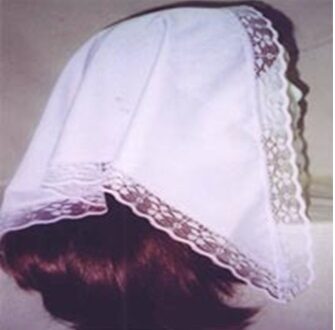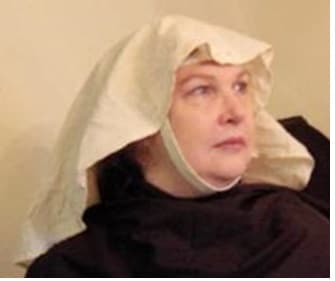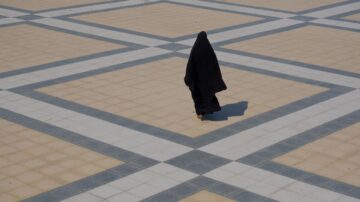A time remembered, is a period of historical films on British history, when to see a woman veiled was quite normal. To surf on the Internet, one could be led to believe that the veil begins and ends with Islam, or as a wedding dress accessory. The event of banning the veil in France has only served to show how much is based on a gut reaction, so deep that there is a past to it. Another misnomer is that the underlying reason President Chirac banned all religious symbols, is because he is a desperate man trying to quell the growing uncontrollable tide of anti-Semitism in France.

The last time one looked, Jews indigenous to the Middle East were of the same Semite race as those they feel superior to-the Palestinians (both Christian and Muslims)! As such, the growing attacks against Jews spreading across Europe, in Britain, Germany, Italy and Belgium etc. has been engineered to turn against Muslims. This has symbolized how far humanity has to go before it can become humane, where men women and children have taken to the streets in the twenty-first century to march for their individual rights. The suffragettes once fought for women’s rights, which only imprisoned women into slavery to the body beautiful, against the dictates of a Christian Europe that incarcerated women to a life of servitude in mind and body, when Islam had given Muslim women their rights.
This dictate, descends from the Christian Bible which states in 1Corinthians 11:
4 Any man who prays or prophesies with his head covered brings shame upon his head. But any woman who prays or prophesies with her head unveiled brings shame upon her head, for it is one and the same thing as if she had had her head shaved. For if a woman does not have her head veiled, she may as well have her hair cut off. But if it is shameful for a woman to have her hair cut off or her head shaved, then she should wear a veil. 5 A man, on the other hand, should not cover his head, because he is the image and glory of God, but woman is the glory of man. For man did not come from woman, but woman from man; nor was man created for woman, but woman for man;” (NAB)
Further clarification is given in 1 Timothy II 8-9 of the Gospels:
For this I was appointed preacher and apostle (I am speaking the truth, I am not lying), teacher of the Gentiles in faith and truth.3 It is my wish, then, that in every place the men should pray, lifting up holy hands, without anger or argument. Similarly, (too,) women should adorn themselves with proper conduct, with modesty and self-control, not with braided hairstyles and gold ornaments, or pearls, or expensive clothes, but rather, as befits women who profess reverence for God, with good deeds. A woman must receive instruction silently and under complete control. I do not permit a woman to teach or to have authority over a man. 4 She must be quiet.” (NAB)
Hence, it is written in the early codes of Christianity that women should veil. Far from ending in the past, the veil was used to subjugate women in Christianity. It was the first Latin theologian of the second and third centuries, Quinus Septimus Florens Tertullianus, who, with fervor, wrote on the veiling of women:
“ For that custom which belies virgins while it exhibits them, would never have been approved by any except by some men who must have been similar in character to the virgins themselves. Such eyes will wish that a virgin be seen as has the virgin who shall wish to be seen. The same kinds of eyes reciprocally crave after each other. Seeing and being, belong to the self-same lust…
The matter that has been left to choice, for each virgin to veil herself with, as she might have chosen, just as (she had equal liberty)… But when the power of discerning began to advance, so that the license granted to either fashion was becoming the means whereby the indication of the better part emerged; immediately the great adversary of good things and much more of good institutions set to his own work…
Every public exposure of an honorable virgin is (to her) a suffering of rape: and yet the suffering of carnal violence is the less evil, because it comes of natural office. But when the very spirit itself is violated in a virgin by the abstracting of her covering, she has learnt to lose what she used to keep….”
The Western patriarchal view of women can be embodied as Tertullianus wrote:
“It is not permitted for a woman to speak in the church; but neither (is it permitted her), to teach, nor to baptize, nor to office.
It remains likewise that we turn to (the virgins) themselves, to induce them to accept these (suggestions) the more willingly… But we admonish you too, women of the second (degree of) modesty, who have fallen into wedlock, not to outgrow so far the discipline of the veil, not even in a moment of an hour, as, because you cannot refuse it, to take some other means to nullify it, by going neither covered nor bare….Arabia’s heathen females will be your judges, who cover not only the head, but the face also, so entirely, that they are content, with one eye free, to enjoy rather half the light than to prostitute the entire face. A female would rather see than be seen”.
Enveloped in the Western perception of women is the “Fall of Eve”, which has shaped Western societal norms throughout the centuries. Christian scholar Leland Haines spells it out: “It was only the wealthy that one can find explored their sense of sexuality outside of social mores. Not to wear the veiling implies freedom from submission to man. (Haine p.3).
Medieval Era
The noblewomen covered their hair with bonnets and veils, especially after the church issued an edict that women should keep their hair covered.

Middle Ages
A lot of Western women’s frustration over their gender can be attributed to the church, as opposed to Christianity and the general view of women in society. During this period, single, divorced and noblewomen had the right to possess property, a right that was lost.
once they married. Women could trade, save money and were legally liable until then. Under French “Salic Law”, in the sixth and seventh centuries, women could inherit land as long as there were no male relatives. It was a combination of the theologies of Aristotle and Augustus that culminated in Thomas Aquinas, Head of the English Church, firmly establishing in this period the belief that a woman’s role was solely to marry, procreate and raise children. Any intellectual pursuit was the prerogative of men. Women were inferior and the causes of evil. It was this that increased the flow of women to become nuns, where they could have some degree of control over their lives (usm p. 1, 2).
Elizabethan Period
The “snood” that arose out of the Tudor period, became the rage with fashion trendsetter of the day, Queen Elizabeth. Crocheted or beaded, snoods kept the hair out of the way and clean. They are still popular today,
Victorian Period
Often deemed the most oppressive period in Western women’s history, it was during the middle of the nineteenth century that hair started to hang loose at the nape, with curls, crimps and all kinds of tantalizing hairstyles. The agricultural revolution offered more food than before, and the industrial revolution offered new jobs, new towns, new societies, plus more and varied commodities. Queen Victoria’s introduction of the wedding dress gave a new life to the veil. It set a trend that has become a dream for most girls.
19th Century
With major renovations taking place in Paris, doctors were strongly recommending that women wore veiled bonnets to protect themselves from dust and airborne diseases. In fact it was fashionable to the extent that women viewed the veil as a symbol of high-class and respectability. Art historian Dr. Marni Kessler, as a male, held contradictory views on the subject, but stated that the veil provided a barrier between the woman and the city. “She was not blinded by the veil, but nevertheless held back, protected and shielded from modern life”. (Barker p.1).
Hence, women were appendages of men, and the property of men, with no rights of their own, as embodied in Christian teachings. Is it embedded somewhere in their trace memory every time they look at a veiled Muslim woman? Can it not be seen that, unlike certain Christian teachings of old, the veil in Islam is not about subjugation to men, but about not being subjugated to the body. Can it not be seen that the rights of women in Islam are written into Islam, and are not an influence from elsewhere?
Western women were void of any sort of rights until the nineteenth century. That past was to be broken with the advent of industrialization, which only respects profits not rights. Through the vehicle of the Suffragette movement, women became free from one form of slavery and bound into the slavery of the body. Believing to be free, Western women were no longer appendages of men. The fast sweeping changes were too much for some. The Free Church rose, part of which is the conservative Christian group the Amish, who separated themselves from a world they rejected and followed strict codes against military involvement; the older members are even against the use of electricity. The veil was a part of the Amish wife’s daily wear (Headcoverings p.1) and some communities still hold onto these traditions.
- Dehumanization: Hair Crazy
- The High Cost of Sexploitation
- Dissolving a Myth
Dehumanization: Hair Crazy
For many women today, the hair has become all too important; the essence of femininity has been associated with the hair. Yet, in the West, up until the twentieth century hairstyling was limited to the upper classes. We never think of how much we adulterate hair with the many harsh chemicals found in modern day shampoos and permanent dyes. Whatever the tradition, in general, the hair when styled was confined by shaving, cutting, the hairstyle itself, and veiling-except for those where every ploy was used to entice the men, as long tresses held much provocation. Otherwise, it was considered unhygienic and impractical to have the hair loose.
To show how obsessed with visual appeal we have become, a poll by Yankelovich Partners in 2001 showed that 69% of Americans felt that clothing, hair and make-up were the most important determining factors in deciding on whether or not one got a job, 67% said that ones appearance affects whether one gets a new challenge, responsibility or opportunity. Can you believe that 78% of Americans felt that clothes, hair and make-up affect ones ability to do the job? However, one should bear in mind that Yankelovich were sponsored by the Cosmetic, Toiletry and Fragrance Association to provide this survey! (womenwork.org p.1).
It is almost as if those that seize the opportunity to attack Islam through the issue of women, or use Muslim women to unload what is still imbedded in their psyche from an oppressive past, have associated the Islamic veil as a tool of male chauvinism under the guise of “Islamic fundamentalism”. Yet they have no working alternative to put in its place! They use the old game of “labeling” in the church. “The technique of labeling is used to discount a person who opposes the beliefs of a religious addict. Labeling attempts to dehumanize persons, so that dismissing them or their opinions is much easier. Choosing not to address someone individually who has doubted the toxic faith, the religious addict places a blanket negative label on all who would disagree with his or her personal habits. Rather than state that John Smith has made a negative statement, the addict proclaims that there are ‘detractors’, ‘traitors’ or ‘malcontents’ who would destroy the ministry or organization. The label becomes a rallying point under which the other followers can be moved to action to squelch a revolt”! (spiritualbase p.1).
Therefore, as such, the rallying cry has been made and we raise our voices, the question is not if, but when will there be success in de-robing the Muslim woman? This is the idea after all, to make the Muslim woman feel as if she is old-fashioned, therefore making her react emotionally to what is going on and unwittingly undo all that supports the fabric and well-being of a Muslim society-the family. The fairy-tale of Rapunzel was only enchanting to many because of the length of her hair, which her knight in shining armor used to climb his way into her heart. People have been made to feel inferior because of their hair:
“We are still enslaved in our thinking.
Society has molded us in our speaking.
I have a problem with the word nappy because it is not being associated with our true identity as being happy.
Why do I have to have a chemical on any of my hairs?
I don’t want to conform to any standard of theirs.
They are those who impose their repressed feelings on the impressionable youth.
Who are just learning to love themselves inside and out.
Youth who want only to fit in with a set standard of beauty, without a doubt.
We as a people need to come together on this.
Most are living happily because ignorance is bliss.
They don’t know that saying “good hair” is as degrading as using the N-word as a term of endearment.
By changing our thinking, we can not only come out of darkness mentally but come out of our concealment!” (nappyhair.com)
Many distance themselves from others because of the loss of hair in illness. One teenager wrote:
Her hair. Her hair was like an ocean with curls and curls and waves. There were red streaks, in her long brown hair; her eyes were emeralds, her skin a golden bronze. She is my best friend. I would do anything to have her hair – the way it fell against her shoulder, like a golden maple frame around a beautiful picture. “What’s chemo?” I asked as Mom pulled me aside. I hope she doesn’t die. I hope she can still have her hair. But; she can’t, and it fell out. She had Hodgkins disease and she lost her hair. Seeing her in the hospital with clearly painful tubes tied to her chest, with massive grey machines attached to her – without her hair. It was hard to look. To see her hurting so badly, made me hurt too, so I cut my hair. by Ashley Nestor, New City, NY” (Ashley, teenink.com).
The High Cost of Sexploitation
We are in denial, I think, as to what impact the hair has in determining who we are, not because it actually does, but for some deeper meaning. It has an illogical affect on human beings that can make one like, hate, resent, bully, desire and reject a person, and for no other reason. Every physical feature on a woman’s body has to have a visual appeal that some non-Western women try to emulate. That visual appeal has become packaged as sex; sex as a commodity. Beautiful women have become visually available to sell the unsellable. Sexploitation invites men to possess with their eye what they cannot possess with their hands, playing on the desires of men, heightening their sensibilities to a point where many find it difficult not to take what they have been “invited” to take. The illusion of women’s rights in the West have been at the cost of men’s rights, only serving to enslave both genders to the unalienable right “to have”. The other term for it is “consumerism”-the same consumerism that is the bedrock of Western industrialization, colonialism and globalization; and has led to all forms of violence occurring in civil society.
The RAINN Organization that provides the National Sexual Assault Hotline in the US states: “Every two minutes, somewhere in America, someone is sexually assaulted”. There were 247,730 victims of rape in 2002, 44,000 of those rape victims were under 18 years of age. Ninety three percent of juvenile sexual assault victims knew their attackers, 34% were family members and only 7% of the attackers were strangers (rain.org p.1, 2). This only serves to show how even the individual concept of family is being eroded.
Dissolving a Myth
When women choose to neglect their rights as recognized under Islam, they also become negligent of the possible consequences, not only to themselves, but also to their families, and society as a whole. The veil is a protection of those rights, which a few non-Westerners are beginning to wake-up to. Transforming the common Western perception of veiled Muslim women, that was shaped by their own past, Mary Walker, production coordinator for the BBC2 series “Living in Islam”, said in Impact Magazine:
“To me the veil symbolized the oppression of women, making them invisible, anonymous and voiceless, and the cause of this oppression lay in the will to perpetuate the family and maintain a patriarchal framework-the very basis of an Islamic Society. I thought women were entirely submerged by divine justification of their role as wife and mother… “Living in Islam” was filmed over two years in 19 different countries, and on location, I was a lone female in an otherwise male team… The first Muslim woman I met in Mali was far removed from my preconception about the Muslim female. She was the wife of a sheikh dedicated to converting pagan villagers to Islam. A sophisticated, well-educated woman, previously married to a diplomat, she had renounced a Western lifestyle for a life in purdah…
The emancipated woman in the West faces the conflict between confirmation of her femininity and the privileges that she associates with it, and repudiation of the confines of her female role and all the limitations that men want her to assume. From where I stood, this woman had transformed those limitations into privileges… On my next trip to northern Nigeria, I met two more women who would alter my views even further… Once again, they had rejected the Western lifestyle, which I considered so superior to Islam in its treatment of women… The women talked, and in their answers, I saw seeds of my own re-evaluations. They argued that the veil signified their rejection of an unacceptable system of values that debased women, while Islam elevated women to a position of honor and respect. “It is not liberation where you say women should go naked”. Just as to us the veil represents Muslim oppression, to them miniskirts and plunging necklines represent oppression. They said that men are cheating women in the West. They let us believe we’re liberated, but enslave us to the male gaze….”
The tresses of forgetfulness is what fell with an enchanting dance,
To grace her body in the glowing sun.
Those tresses caught not his eye, but his senses, and could not,
Would not, rise above that trance,
His imagination unfolded passions within from where he cared not,
For all he saw in that moment
Was a need to fulfill what lied within with what he saw –
Who she was
Did not matter, neither did her honor.
By Hwaa Irfan

















